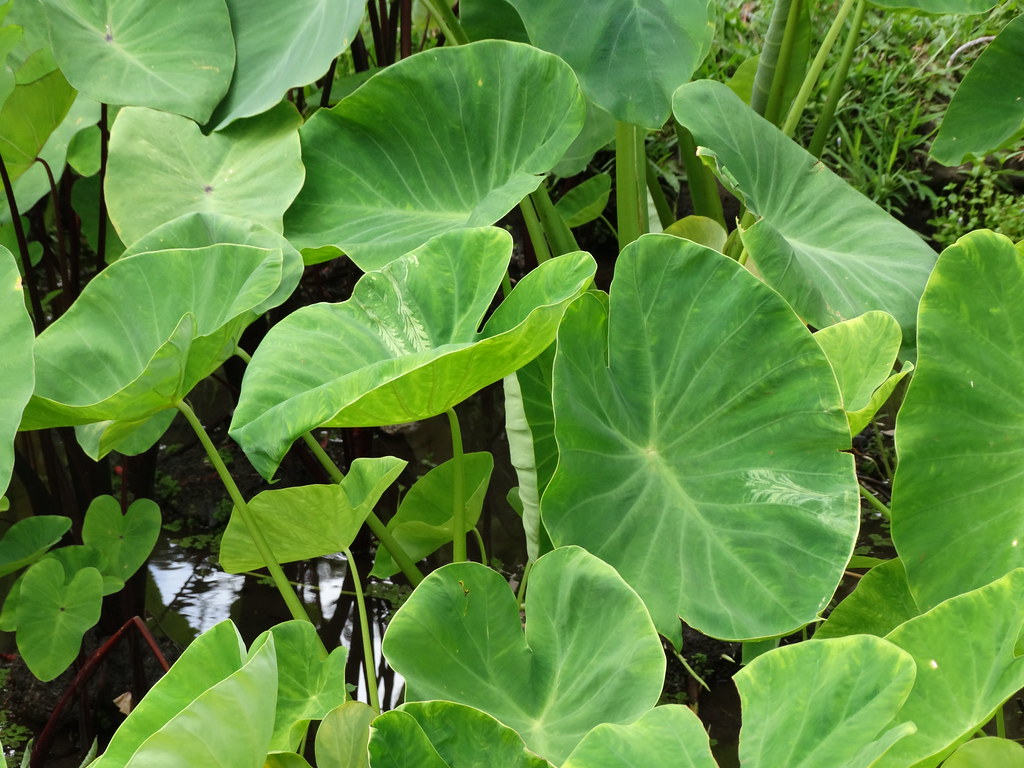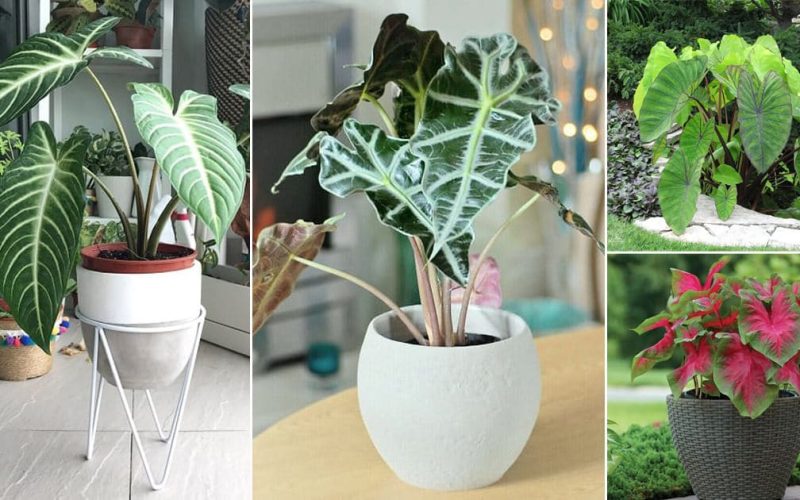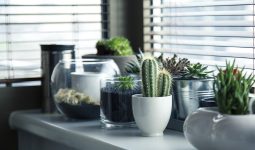Elephant ear houseplants, otherwise known as Alocasia or Colocasia, are among the most popular plants in the world.
These large and lush tropical plants are great to have inside your home.
They can bring beauty and many health benefits that can help you sleep better and improve your overall well-being.
Here are the top types of elephant ears you should know about if you don’t already own one or two!
1. Colocasia Esculenta

Known by the scientific name Colocasia Esculenta, Elephant Ear plants belong to the arum family (Araceae).
They originate from humid tropical rainforests in Sri Lanka, India, and Southern China.
These are one type of elephant ear with large leaves that can grow up to four feet across.
They are considered tender perennials and should be planted outdoors in spring or autumn for optimum growth.
2. Black Magic
Most gardeners and flower enthusiasts know that the popular elephant ear plant’s sprawling leaves and jumbo-sized ears make it an attractive addition to any garden or home.
For those wondering about this huge, old-fashioned perennial plant’s uses, here are five benefits that make these types of elephant ears well worth growing in your home:
- Excellent for heavy clay soil—This plant’s dense leaf layer helps loosen heavy clay soil and add nutrients to depleted soil. It can also absorb large amounts of water, assisting both problems.
- Shade provider – Like many plants with dark green leaves, elephant’s ears are a great source of shade when planted around taller plants that need protection from the sun.
3. Black Stem
The black stem of this plant can be incredibly attractive and easy to maintain. These types of elephant ears are pretty much unkillable. This makes them a great choice for novice gardeners or apartment dwellers with little outdoor space.
Their leaves are also tougher than most and won’t wilt if they’re in the shade. This makes them perfect for those locations where natural light isn’t readily available.
Black-stemmed plants typically only need about a half gallon of water per week, too, which makes them less labor-intensive to care for! Their versatile elephant ear houseplant can grow in just about any location or type of soil condition.
Another perk is that their invasive roots will help absorb minerals from your soil, improving its quality over time.
4. Diamond Head
This is among the types of elephant ears known as Kalalau in Hawaii. They’re more common on the mainland U.S. and should not be confused with the giant, deep-rooted Asian elephant ears used in yards there.
Kalalau have a shallow root system and live exclusively on the leafy upper part of their leaves, called spathes.
The major difference between Kalalau and grasses or palms is that they produce new leaves on old ones rather than at their tips like grasses or their tops like palms do.
5. Hawaiian Punch
You may know this plant as the Taro plant, but we call it by its scientific name. Alocasia (pronounced a-low-Kah-SEE-ah) is the type of plant we are discussing, but many in the scientific community have other names for it, such as Alocasia odora. The edible parts are called corms, and they look like large potatoes.
An interesting tidbit: while they grow best in wet, humid conditions and make great indoor plants, this particular variety hails from Southeast Asia.
Did you know that when it’s getting close to summertime for these tropical flowers – about August or September – you should remove their soil and store them in dry peat moss?
6. Mojito
These massive, stunning leaves are one of the fascinating plants we grow in our nursery. Mottled foliage provides an amazing focal point in any outdoor space or on a large window sill!
Their captivating leaves have shades of purple, green, and cream and sometimes have a pink blush around the edges.
Also, the texture is like velvety silk, and they never stop growing. The new leaves can grow 6-8 long in just three weeks in the right conditions!
This is one of the types of elephant ears that do very well outside all year round as long as they are planted in fertile soil with plenty of sun or indoors.
Plant them where you want something that looks lush and exotic year-round without needing lots of attention.
7. Illustris
They need minimal sunlight and can thrive in just about any room. Their thick and lush leaves can help keep your home cool in the summer and dry during the winter.
The plant is only semi-hardy, so if you live in a cold climate, you may want to bring it inside for the winter.
The flowers are beautiful but not overpowering. The roots should be pot-bound so they do not grow too much or poke out of their container.
Ensure the pot is at least four inches deep and eight inches wide to accommodate its large root system.
8. Teacup
Whether you want to beautify your home or add peace and tranquility, an Elephant Ear houseplant is the perfect addition to any room.
Teacups are also perfect for fighting indoor air pollution with their large leaves! They can be planted in a pot on the floor or near a window if it has more light.
These teacup plants require very little water and can survive without fertilizers for as long. Planting one near the sink will help clean your air while helping keep dust away! They are also quite low maintenance and perfect for those who don’t have much time.
Ensure they’re not in direct sunlight because it will dry out the plant quickly and lead to dehydration! For all these reasons, an Elephant Ear Houseplant is a must-have in any home!
9. Caladium
Caladium is a succulent, evergreen plant that thrives best in warmer climates. It has many varieties, but bright green leaves with purple markings are the most common.
Elephant Ears grow well indoors and require moist soil at all times. These plants look particularly impressive when grown in large pots or outdoors alongside similar-looking plants such as cannas and lilies.
Their height also works well against taller gardeners with little ones since they can easily conceal more vulnerable parts of the plant from small hands and feet.
The first sign a plant has been touched is often left-hand prints on its leaves, so you’ll know your child has been visiting you!
10. Pink Symphony
Many people worry about not having enough sunlight in their homes and being able to keep plants alive. However, many plants grow indoors well with no direct sunlight.
One such plant is the pink symphony elephant ear houseplant. Growing as tall as three feet offers various health benefits and can be a great addition to any household.
Here are some of the things you should know about this interesting plant:
- These types of elephant ears make beautiful home decor pieces, bringing natural warmth and softness to any room they are placed in.
- They also add humidity to your home by releasing water vapor from their leaves, which helps eliminate dry air inside the house.
- The added humidity also calms those with asthma or allergies due to an overactive immune system.
- Their lush leaves can help purify the air in your home because of their high surface area for photosynthesis and transpiration.
- They are easy to care for because they only need occasional watering, do not require much light or fertilizer, and thrive on neglect!
11. Iceberg
Size doesn’t matter. Some varieties of this plant can be as small as 3 inches but can grow to 3 feet in diameter.
One way to determine how big this iceberg elephant ear will grow is to look at the roots when you first buy it. The more roots there are on the plant, the larger the plant will grow over time.
12. Rose Glow
When we started our search for the perfect indoor plant, we considered many options and read many reviews.
We wanted a plant that would make us happy, feel at home, and not require too much care.
With lush green leaves that can grow up to 3 feet long, you might think this plant requires some upkeep, but in reality, it is easy-peasy.
All you need to do is find a corner with good light (these prefer direct sunlight) and then give them about 10 inches of space, and you’ll be set.
The only time you’ll need to water is when the soil is dry; it’s best not to overwater or water during the night because their roots are shallow.
13. Red Flash
Red flash elephant ear houseplant is large; floppy leaves make it a popular shade provider in a bright room. They do well in low-light conditions and don’t require much watering.
With the right care, they can produce multiple stalks bearing small white flowers throughout the year.
These plants are perfect for setting your design apart with their uniquely shaped leaves that stand upright or droop as if hanging on to some fixture or chain near them (that’s when you know they’re truly happy.
If you’re looking for something with good indoor air quality and low maintenance, this is one of the elephant ears to go for!
14. Alocasia
One of the most popular elephant ears for an indoor plant is the Alocasia, also known as an Elephant Ear houseplant.
They’re easy to maintain and can work in a variety of settings. Here are some of the top benefits of using this lush green plant as your newest indoor addition.
In addition, they’re water efficient. You’ll need to provide a good dose of water and let it drain well before allowing the soil to dry again.
Also, you can get away with watering this plant once or twice a week, and they’ll be happy campers.
15. Amazonica
With its feathery leaves, the Amazonica elephant ear houseplant offers a beautiful contrast in texture and color.
These low-maintenance plants require little more than humidity, light, and water to thrive. Amazonicas are native to regions with high humidity, so these plants do best when living near a moist environment that often feels humid. Elephant ears must be watered regularly (usually twice a week), or the foliage will dry quickly.
If the plant is struggling with too much dryness, try watering it once every two days instead of daily. One way to create a humid environment is to place the pot on top of a tray filled with pebbles and water.
Keep an eye on the tray. If it dries up, you may need to refill it frequently. The key is to use common sense: keep the soil evenly moist but not soggy wet.
16. Xanthosoma
Plant hunters have collected these beauties from the wild for centuries, so it’s little wonder that there are about 200 species in cultivation.
Depending on the species, these plants may grow to 1-3 feet tall and 3-6 feet wide. Their leaves grow from an underground corm and are triangular with a blue-green color.
Also, they come to showy flower spikes, lasting up to six months. This elephant ear houseplant prefers partial shade; they need regular water but avoid soggy soil as it rotates their roots. The most common use is a low hedge or border edging in a shady garden bed.
17. Lime Zinger
Lime Zinger elephant ear houseplants are among the most popular types of elephant ears. They’re easy to care for and look great in any home. The leaves of this plant make a bold, showy statement that will give any room an instant fresh look.
This hardy plant is one that you can confidently let sit in a sunroom or even on your porch without worrying about getting burnt by the sun—they love it!
Don’t have enough space? No problem! This tropical, fern-like leafed variety can be just as happy hanging from your porch ceiling or sitting on a windowsill with bright light during the day and not too much sunshine at night.
18. Lindenii
The linden variety is one of the most popular elephant ears, with wide leaves and a graceful appearance. It can be grown indoors or outdoors. Let’s look at some of the reasons why this plant is so popular among growers:
It has beautiful foliage that looks great against a backdrop. Wide leaves are a welcome sight to any gardener in need of shade.
Large plants provide sturdy support for flower arrangements. This elephant ear houseplant can grow independently and occupy no room in your garden.
Wide-leaved plants provide generous privacy coverage. They are popular with growers because their beautiful foliage looks great against a backdrop.
19. Violaceum
The plants are easy to grow and can be placed outside or in a brightly lit window. They don’t need frequent watering like other plants. Instead, they need a good drink once every week or two.
When the leaves start to yellow, it’s not an indicator that they need more water but rather that they’re getting ready for dormancy for the winter.
Elephant ears release oxygen at night, especially if you live in a small space. These plants are perfect if you want elephant ears that keep your space cool and release extra oxygen!








